|
|
|
Trophy History Page
Posted
4/4/09;
Updated
4/13/24
|
|
|
|
 |
|
|
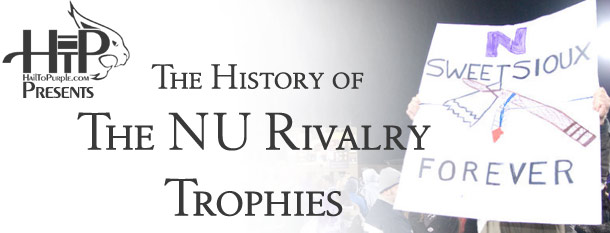

The stories behind NU's football rivalry trophies are not quite as well
known as some of the other Big Ten trophies, such as the Little Brown
Jug-- indeed, there are parts to these stories that are (for now)
completely unknown. But the history of these trophies is still
worth noting, since it tells us something about the schools and fans
that were involved. As NU sets out to initiate a new rivalry
trophy this fall, it is a good time to review, as much as is known,
that history.
To date, NU has had football trophy series with three schools: Notre Dame, Illinois, and-- as of 2021-- Michigan.
The Notre Dame Series
The Shillelagh
(1931 - Effectively 1962)
 NU Archives
NU Archives
According
to NU media guides from the 1960s, "In 1930, William T. Cosgrove,
president of the Irish Free State, presented a shillelagh to Coach
Knute Rockne, famed coach of the University of Notre Dame football
team. Coach Rockne proposed that the Shillelagh become a trophy
for the annual football game between Notre Dame and Northwestern and
the suggestion was readily adopted by the officials of both
schools. The trophy was placed in competition for the first time
in 1930 when the Irish defeated the Wildcats 14 to 0 in a game that
decided the national championship. Both teams came up to the game
undefeated." The guides had at least one fact wrong: Cosgrove gave the
shillelagh to Notre Dame in 1931: the date is actually inscribed on the
stick's silver band:
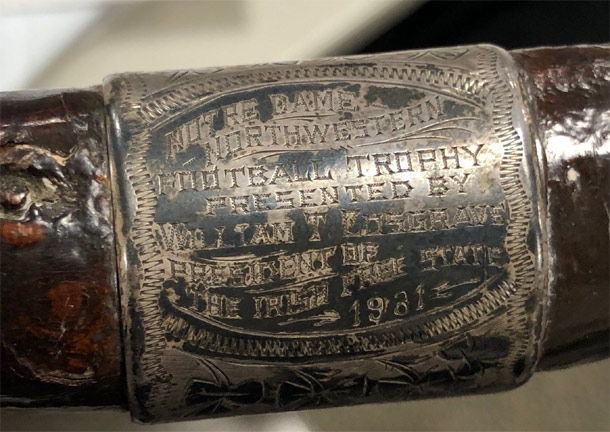 Joe Hoovestol Photo
Joe Hoovestol Photo
Notre Dame still has two other Shillelagh trophies with other schools,
but the historic one that Knute Rockne began with Northwestern is the
oldest (the Purdue Shillelagh began in 1957, and the USC Jeweled
Shillelagh started in 1952) and when it was introduced it was among the
most prestigious rivalry trophies in the nation.
At the time of the start of the NU-ND Shillelagh the two schools were
beginning a true rivalry series: they had played historic games at the
turn of the century and had re-ignited their series in the 1920s, but
starting in 1930 the teams would play each other every year for nearly
the next two decades. From 1930 through 1948 Northwestern had a
mostly winning football program, notching 80 victories to 69
losses. Unfortunately, the series with the Irish wasn't so
competitive: during that same time the Wildcats only beat the Irish
twice and tied them once.
However, when the series resumed in 1959 it was NU's turn to dominate,
knocking off Notre Dame four straight times. The dominance ended
when Coach Parseghian moved from NU to Notre Dame, and NU dropped the
rest of its games to the Irish. This revived series with Notre
Dame concluded in 1976.
As late as 1973 the Shillelagh was still listed as an active trophy in NU's media guides. However, as this article from Notre Dame fan site One Foot Down
states, the Shillelagh was virtually forgotten by the teams after NU's
1959 - '62 winning streak. Apparently, the trophy lay forgotten at NU,
even after Notre Dame returned to dominate the series. During the Pont
years, it apparently disappeared from Evanston. Its status was a
mystery until recently. In 2016, RR Auction offered the Shillelagh in a
collection, with a starting bid of $1,000. Its "owner" had found it
"...being discarded at Northwestern in Evanston sometime in the
mid-1970s." The buyer got the trophy for a final bid and fee totaling $12,344.
In 2018 the Shillelagh's buyer identified himself. Per another article on One Foot Down,
he is Omaha businessman Joe Hoovestol. Hoovestol is a non-alumnus Notre
Dame fan who was "shocked when the auction ended with one of my initial
bids because I was prepared to go a lot higher. I expected some alums
to bid it up." Hoovestol confirmed that the seller was likely a
Northwestern employee who "grabbed it before it went into the trash."
The seller was never named, and the seller's story of how he happened
upon the
trophy is suspect. It is possible that the seller acquired the trophy
via means more foul than fair.
Hoovestol left the door open to the possibility that the trophy might
find its way back into use by the schools. However, it's more likely to
stay in private possession.
|
 The Illinois Series
The Illinois Series
The Fire Bell
(1941 - c. 1943)

Associated Press Photo
If
the above image of the Northwestern - Illinois Fire Bell Trophy looks
like a candid shot of the Loch Ness Monster, it's because getting a photo of this
historic trophy is just about as rare. The trophy began in
1941, as described at the time by the Chicago Tribune:
A
new football trophy will take its place alongside the famed little
brown jug of the Minnesota-Michigan rivalry and the old oaken bucket,
battled for each year by Purdue and Indiana, when Saturday's game is
over. The Wildcats and Illini will be battling for a 100 year old
fire bell taken from the loft of a fire station in Oshkosh, Wis.
R.J. Erdlitz, father of Dick Erdlitz, Northwestern's senior quarter
back, will present the trophy to [NU Athletic Director Tug] Wilson and
Doug Mills, Illinois director of athletics, at a joint alumni luncheon
of the two schools in the Bismark hotel at noon today.
|
The Associated Press story about the trophy on November 20, 1941 noted
that the Fire Bell is "two feet in height and fastened to a wooden
base. . . The scores of each game in the annual series will be
inscribed on the bell and the trophy will be retained each year by the
winning school."
Northwestern
won the first of the Fire Bell Series, 27-0, and kept the Bell.
However, on November 7, 1942, Illinois returned to Dyche Stadium (for
the fourth straight year in the series), and the Illini defeated
NU, 14-7. At the end of the season, at a luncheon with
Chicago-area football fans, Tug Wilson formally handed over the Fire
Bell to new Illinois head coach Ray Eliot.
What
happened to the Bell from that moment on is a total mystery.
No further mention of the Bell is made by the Daily Northwestern, the
Chicago Tribune, or any other known source. Neither the
Northwestern nor the University of Illinois archives has any record of
the bell after 1942. By 1945, NU and
Illinois had moved on to a new trophy, so it is clear that the Fire
Bell was gone by then. It was likely gone by 1943, but that is
not yet confirmed.
So what happened to the trophy? Possibly it was stolen or simply
lost. Considering that it dropped from view as 1943 began, it is
possible that the Bell was a sacrifice to a World War II metal
drive. The research continues.
UPDATE (April 2013): Because the Bell was in the hands of the Illini when it vanished after December 1942, it
made sense to focus further research on Illinois and its archives and
newspaper articles. The Daily Illini, the university's student
newspaper, contains information that seems to add weight to the
assumption that the schools only used the trophy in 1941 and 1942, and
that it was terminated in early 1943.
In October 1943, before the Illini played Purdue (or Northwestern), the
Daily Illini described the upcoming debut of the Purdue Cannon, the
newest Illinois trophy. The article mentions all of the other Big
Ten trophies, but it gives no mention whatsoever of the Bell. It is
reasonable to assume that if the Bell were still in use in October
1943, the Daily Illini would have mentioned it in this article.
So, it is increasingly clear that the Bell dropped away at some point
between late December 1942 and October 1943, and was nearly certainly
not used for the 1943 NU - Illinois game. The big question,
however, remains: what happened?
In the initial article about the Fire Bell, I speculated that the trophy was
possibly sacrificed in a scrap metal drive. This seems a
reasonable assumption: between late 1942 and late 1943 college campuses
across the country were conducting massive scrap drives for the war
effort. Americans eyed any shred of metal that was not essential,
looking for war material. This was the fate of at least one
university bell: Western Michigan's Victory Bell, rung during home
football games, was donated to a metal drive in October 1942. A
bell like the NU - Illinois bell, made in the 1840s, would have been
made with bell metal-- a bronze with a high copper content-- which
would have been desirable.
It now appears likely that this was, indeed, the fate of the Fire Bell
trophy. Again, there is absolutely no mention in any source of
the Bell trophy after December 1942. However, the Daily Illini
does mention other trophies at the school, and they wind up on the
war's scrap heap.
On October 7, 1942, the newspaper reported that the Illinois salvage
section of the War Production board recommended that the university's
fraternities should donate all of their intramural trophies to the war
effort. The board's representative stated, "Every trophy... no
matter how small, would be of great value... Our supply of tin is
practically exhausted. Those cups standing on fraternity trophy
shelves contain a great deal of tin..."
And in February 1943, the university, in conjunction with the rest of
Champaign-Urbana, conducted a massive metal drive and parade, hauling
in old cars, other remaining trophies, and any piece of metal that was
not necessary. Although we may never know for sure what happened
to the original Northwestern - Illinois trophy, it is now very likely--
given the atmosphere on the Illinois campus at the time and the fact
that sports trophies had actually been targeted-- that the Bell was
placed into the February 1943 scrap heap.
|
Sweet Sioux
(1945 - 2008)
The most well-known of NU's rivalry trophies, Sweet Sioux was an
appropriate trophy for a 'Cat, since it had nine lives, or nearly as
many forms...
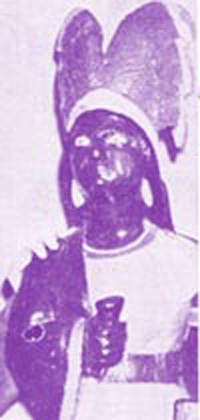 NU Archives
NU Archives
Sweet Sioux Statue
(1945 - 1946)
Unveiled the week before the 1945 NU-Illinois game, "Sweet Sioux" was
the winning entry, submitted by Bob Mitchell. It isn't
known for certain, but the inspiration for the entry might have been a
Warner Brothers cartoon from several years before, which had the same
title. On announcing the new trophy, the Daily proclaimed, "The
name of this trophy will stand for collegiate football rivalry in this
school for many years. This is a significant moment in our school
record."
The story of the change from Sweet Sioux the statue to Sweet Sioux the
tomahawk has always been based on the assumption that the statue was
stolen from its spot at NU in 1946. The teams, the story goes,
decided to replace the statue with a tomahawk in 1947 and, when the
statue resurfaced some time later, the schools opted to keep the
tomahawk because it was easier to transport.
However, the Daily Northwestern's coverage at the time adds some
clarifying detail to the traditional legend. If you look closely
at the statue above, it appears that the figure is holding
something. In a somewhat tongue in cheek article published the
week before the 1946 game with Illinois, the Daily noted that the
statue's tomahawk
was missing: "[students are] looking for a missing tomahawk which
sometime in the distant past was broken from the Indian's hand.
With the Illinois game only a few days away, the athletic department
was aghast when they realized the perpetual trophy between Northwestern
and Illinois is not complete. . . They noticed that some object had
apparently been broken off the end of the handle butt which the Indian
holds in its right hand. . . The Indian had no tomahawk when it was
purchased."
 The statue's original tomahawk, recovered
Daily Northwestern photo, from NU Archives
The statue's original tomahawk, recovered
Daily Northwestern photo, from NU Archives
Days after this "incident," members of Acacia tracked down the tomahawk
and decided to reunite it with the statue in a ceremony at
halftime. By that point the schools were already starting to
treat the tomahawk as the central object for the rivalry. It was
decided just before the 1946 game that, no matter who won, the statue
would stay at NU for the next five years, and the statue's tomahawk would become the spoils of
battle. So, for 1947 the Tomahawk was to be the central object for the rivalry.
It was only after the 1946
game that the statue itself was stolen from its showcase at NU's Patton
Gym. By then, however, it had already been
"semi-retired." A Northwestern student located the statue
in November 1949.
Acacia, the fraternity which had originally discovered Sweet Sioux,
reclaimed the statue. The statue remained in the fraternity house
until a 1985 fire. It is believed that the Sweet Sioux statue was
a victim of that fire.
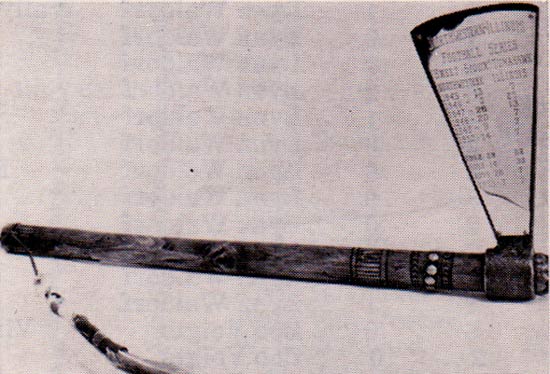 NU Archives
NU Archives
Sweet Sioux Tomahawk II
(1947 - c. 1970)
Strangely,
the Tomahawk series did not use the very same tomahawk that belonged
with the statue. The original
tomahawk might have been stolen in November 1946, along with the
statue; if it was, it does not appear to have been returned with the
statue:
 Daily Northwestern photo, from NU Archives
Daily Northwestern photo, from NU Archives
Instead, the tomahawk shown above was
used. For the early years in the series, the scores were engraved
directly on the polished plate attached to the blade.
This trophy was used until the late sixties. By 1972, it was
retired. (its termination possibly happened earlier, around
1970). The retired Tomahawk II, like all the other versions of
Sweet Sioux, landed at Northwestern. Today Tomahawk II can be seen
behind glass at NU, right next to the Land of Lincoln Trophy (when the
LOL is in NU's possession).
 NU Archives
NU Archives
Sweet Sioux Tomahawk III
(c. 1970 - 2008)
At some point between 1969 and 1972, the Sweet Sioux became a framed representation of
a tomahawk, with the scores of the NU - Illinois series engraved on
a plate, rather than on the tomahawk itself. The tomahawk in the
frame was new (clearly not the same as Tomahawk II). The odd
little
trophy lasted longer than any other version.
By 2007, the NCAA had required that the University of Illinois
eliminate all use of Native American icons and symbols.
That included the team's mascot, Chief Illiniwek. In 2008 the
NCAA expanded its decision to include the Sweet Sioux Trophy. The
schools announced the week before the 2008 NU-Illinois game that the
Tomahawk would be retired after the game and, regardless who won, would
rest at Northwestern for good. NU won the final game of the
series, 27-10.
|
|
Land of Lincoln Trophy
(2009 - Present)
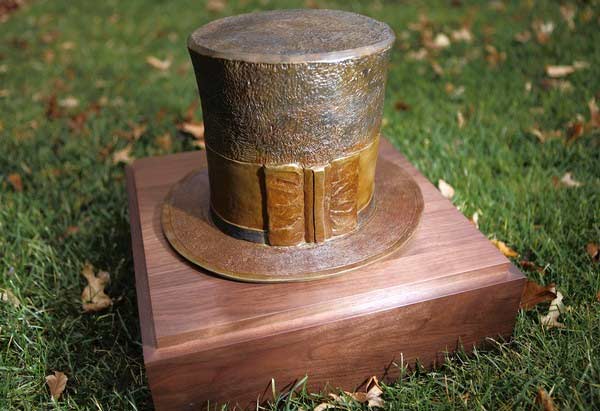
The trophy's debut at Northwestern, November 10, 2009. Chicago Tribune photo
After
Sweet Sioux was retired, NU and Illinois announced that the schools
would hold a contest to determine a successor trophy. Four
finalist candidates were chosen for the contest (including The
Graham-Grange Fire Bell, which was submitted by HailToPurple.com). The winning entry was the Land of Lincoln Trophy.
The winning entry described the Land of Lincoln Trophy as a
representation of Lincoln's stove pipe hat, fixed to a wooden
base. The schools gave the concept to Pulitzer Prize winning
cartoonist Dick Locher, who designed the trophy. Locher, a
well-known editorial cartoonist and Naperville resident, served for
years as the artist of the Dick Tracy comics.
Since NU won the final battle for Sweet Sioux, the new trophy was
delivered to Evanston in 2009, and NU brought it with them to Champaign for
the inaugural game on November 14. The Wildcats won that game, keeping the LOL Hat for the first year of the series.

The LOL Trophy, resting in 2016 at NU, right next to Sweet Sioux Tomahawk II. NU Sports Photo
|

The Michigan Series
George Jewett Trophy
(2021 - Present)
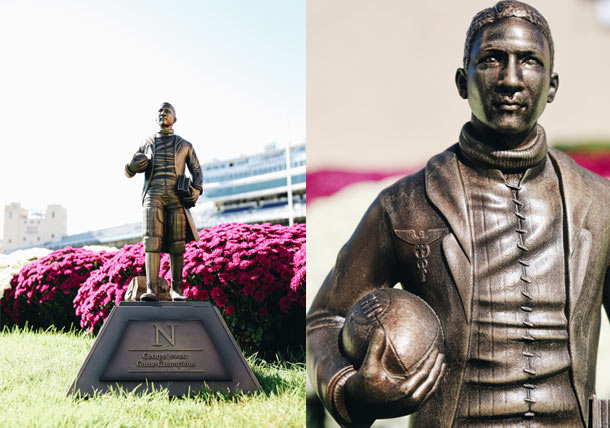 Northwestern Images
Northwestern Images
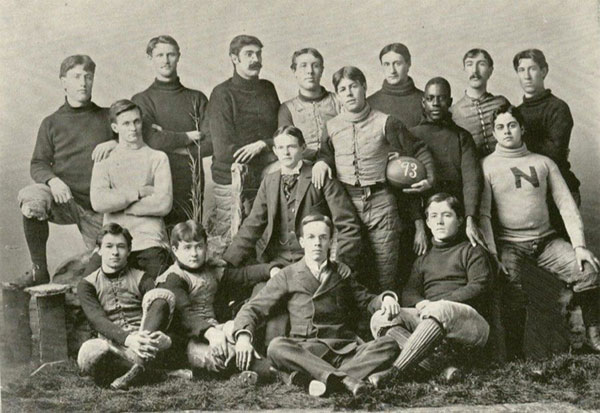
The 1893 Northwestern team, featuring Jewett.
On
February 25, 2021, Northwestern and Michigan jointly announced the
formation of the George Jewett Trophy, the first FBS football rivalry
trophy to honor an African-American player. The two schools will begin
their series for the trophy at their 2021 game in Ann Arbor. During the
founding announcement, Northwestern President Morton Schapiro said, "George
Jewett embodied the student-athlete ideal for Northwestern and for
Michigan... I'm thrilled that our two universities could come together
to honor that ideal through a new shared tradition."
Jewett was the second Black player in major college football, the first
in the Big Ten, and the first for both Michigan and Northwestern.
Hailing from Ann Arbor, Jewett played for Michigan in 1890 and 1892. In
fact, Jewett played in the very first game between Northwestern and Michigan,
staged in Chicago in 1892. Jewett kicked a field goal for the
Wolverines, but Michigan lost, 10-8. He left Michigan in 1893 to
complete his medical degree at Northwestern and played for the Purple
in 1893 (scoring a touchdown for NU in a losing effort vs. his former
team) and 1894. Dr. Jewett died at age 38 in 1908.
On
October 18, 2021, Michigan Coach John Harbaugh unveiled the George
Jewett trophy to the press, five days before the first game in the new
series. "It has great significance," Harbaugh commented, "The first
trophy in FCS history that is a trophy for an African-American
student-athlete."
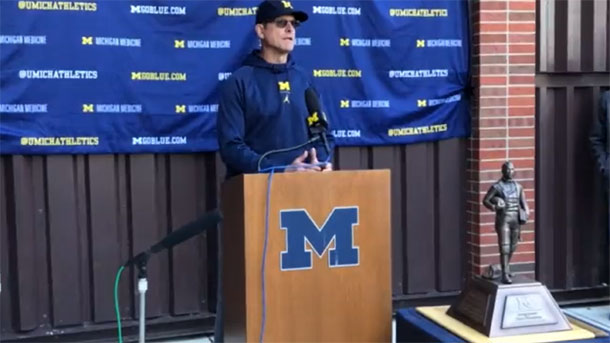 Screenshot image from Detroit News video
Screenshot image from Detroit News video
The
new trophy is 36 inches tall, bronze, and depicts Jewett wearing both a
football uniform and a medical coat. He is carrying both a football and
textbooks. The trophy's base contains plaques identifying Jewett, a
Michigan logo, and a Northwestern logo. The sculpture of Jewett can
rotate on the base, facing either the Michigan or NU logo, depending on
which team claims the trophy. It is likely the first-ever trophy the
appearance of which changes depending on the winning team.
Unlike other trophies, which are paraded on the field by the winning
team, the Jewett trophy awaits the winning team in the locker room
after the game. Michigan won the first game for the trophy, 33 to 7.
|


|
|
|

